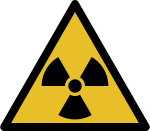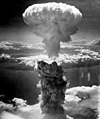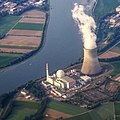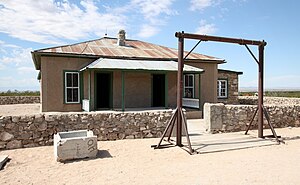The Nuclear Technology Portal
Introduction

- Nuclear technology is technology that involves the nuclear reactions of atomic nuclei. Among the notable nuclear technologies are nuclear reactors, nuclear medicine and nuclear weapons. It is also used, among other things, in smoke detectors and gun sights. (Full article...)
- Nuclear power is the use of nuclear reactions to produce electricity. Nuclear power can be obtained from nuclear fission, nuclear decay and nuclear fusion reactions. Presently, the vast majority of electricity from nuclear power is produced by nuclear fission of uranium and plutonium in nuclear power plants. Nuclear decay processes are used in niche applications such as radioisotope thermoelectric generators in some space probes such as Voyager 2. Generating electricity from fusion power remains the focus of international research. (Full article...)
- A nuclear weapon is an explosive device that derives its destructive force from nuclear reactions, either fission (fission bomb) or a combination of fission and fusion reactions (thermonuclear bomb), producing a nuclear explosion. Both bomb types release large quantities of energy from relatively small amounts of matter. (Full article...)
General images -
Selected article -
The development effort initially focused on a gun-type fission weapon using plutonium called Thin Man. In April 1944, the Los Alamos Laboratory determined that the rate of spontaneous fission in plutonium bred in a nuclear reactor was too great due to the presence of plutonium-240 and would cause a predetonation, a nuclear chain reaction before the core was fully assembled. Oppenheimer then reorganized the laboratory and orchestrated an all-out and ultimately successful effort on an alternative design proposed by John von Neumann, an implosion-type nuclear weapon, which was called Fat Man. A variant of the gun-type design known as Little Boy was developed using uranium-235.
Chemists at the Los Alamos Laboratory developed methods of purifying uranium and plutonium, the latter a metal that only existed in microscopic quantities when Project Y began. Its metallurgists found that plutonium had unexpected properties, but were nonetheless able to cast it into metal spheres. The laboratory built the Water Boiler, an aqueous homogeneous reactor that was the third reactor in the world to become operational. It also researched the Super, a hydrogen bomb that would use a fission bomb to ignite a nuclear fusion reaction in deuterium and tritium.
The Fat Man design was tested in the Trinity nuclear test in July 1945. Project Y personnel formed pit crews and assembly teams for the atomic bombings of Hiroshima and Nagasaki and participated in the bombing as weaponeers and observers. After the war ended, the laboratory supported the Operation Crossroads nuclear tests at Bikini Atoll. A new Z Division was created to control testing, stockpiling and bomb assembly activities, which were concentrated at Sandia Base. The Los Alamos Laboratory became Los Alamos Scientific Laboratory in 1947. (Full article...)
Selected picture -
Did you know?
- ... that Project Carryall proposed the detonation of 23 nuclear devices in California to build a road?
- ... that T. K. Jones thought that a nuclear war was survivable if "there are enough shovels to go around"?
- ... that Helen Steven shared the Gandhi International Peace Award for her opposition to the nuclear submarine base in Scotland?
- ... that before becoming a successful children's author, Myron Levoy was an engineer doing research on nuclear-powered spaceships for a mission to Mars?
- ... that during World War II, pilot G. E. Clements was removed from training for secret missions associated with the Manhattan Project when senior officers realized she was a woman?
- ... that plutonium produced in the nuclear reactors at the Hanford Engineer Works was used in the Fat Man bomb used in the atomic bombing of Nagasaki in August 1945?
Related WikiProjects
Things you can do
| Parts of this portal (those related to section) need to be updated. Please help update this portal to reflect recent events or newly available information. Relevant discussion may be found on the talk page. (September 2021) |
Selected biography -
Franck became the Head of the Physics Division of the Kaiser Wilhelm Gesellschaft for Physical Chemistry. In 1920, Franck became professor ordinarius of experimental physics and Director of the Second Institute for Experimental Physics at the University of Göttingen. While there he worked on quantum physics with Max Born, who was Director of the Institute of Theoretical Physics. His work included the Franck–Hertz experiment, an important confirmation of the Bohr model of the atom. He promoted the careers of women in physics, notably Lise Meitner, Hertha Sponer and Hilde Levi.
After the Nazi Party came to power in Germany in 1933, Franck resigned his post in protest against the dismissal of fellow academics. He assisted Frederick Lindemann in helping dismissed Jewish scientists find work overseas, before he left Germany in November 1933. After a year at the Niels Bohr Institute in Denmark, he moved to the United States, where he worked at Johns Hopkins University in Baltimore and then the University of Chicago. During this period he became interested in photosynthesis.
Franck participated in the Manhattan Project during World War II as Director of the Chemistry Division of the Metallurgical Laboratory. He was also the chairman of the Committee on Political and Social Problems regarding the atomic bomb, which is best known for the compilation of the Franck Report, which recommended that the atomic bombs not be used on the Japanese cities without warning. (Full article...)
Nuclear technology news
- 21 June 2024 – France–Niger relations
- Niger's military junta revokes the operating license of French nuclear fuel producer Orano at the Imouraren uranium mine amid tensions between the two countries. (BBC News)
- 13 June 2024 –
- A Russian warship and a nuclear-powered submarine conduct military drills in the Caribbean sea simulating a missile strike on enemy ships after passing near the coast of Florida in order to reach Havana, Cuba. (AP)
- 11 June 2024 – Russian invasion of Ukraine
- Russia and Belarus begin the second stage of their tactical nuclear weapons drills. (The Independent)
Related portals
Related topics
Subcategories
Associated Wikimedia
The following Wikimedia Foundation sister projects provide more on this subject:
-
Commons
Free media repository -
Wikibooks
Free textbooks and manuals -
Wikidata
Free knowledge base -
Wikinews
Free-content news -
Wikiquote
Collection of quotations -
Wikisource
Free-content library -
Wikiversity
Free learning tools -
Wiktionary
Dictionary and thesaurus







































































































